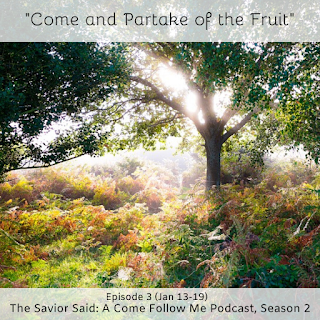S2 E3 (Jan 13-19) "Come Partake of the Fruit"
Listen to S2 E3 (Jan 13-19) "Come Partake of the Fruit" here:
Podbean: https://thesaviorsaid.podbean.com/
Spotify: http://ow.ly/Zpg650uuNjg
iTunes: http://ow.ly/RGeQ50uuNjb
Stitcher: http://ow.ly/H4Lu50uuNja
Close your eyes. Take a moment to visualize what you think Lehi's Dream looks like. Did you know that picture is completely personalized to you? We talk about how the language in Lehi's Dream allows each of us to picture different things as we think about Lehi's Dream. Also the interesting appearance of similar dreams in history! So come, partake of the fruit and let's chat about Lehi's Dream!
(1 Nephi 8:10 "I beheld a tree, whose fruit was desirable to make one happy")
I see the fruit as a pear/peach (but white and glowing, like a firefly!) hybrid:
(1 Nephi 8:11 "And it came to pass that I did go forth and partake of the fruit thereof; and I beheld that it was most sweet, above all that I ever before tasted. Yea, and I beheld that the fruit thereof was white, to exceed all the whiteness that I had ever seen.")
The path leading to the tree is a red dirt path in a green grass field
(1 Nephi 8:9 "I beheld a large and spacious field.')
(1 Nephi 8:9 "I beheld a large and spacious field.')
(1 Nephi 8:20 "And I also beheld a strait and narrow path")


My iron rod (and it was weirdly important to me to show it as a simple iron rod- no other bars or ornamentation on it):
(1 Nephi 8:20:"...which came along by the rod of iron")
And this is the parking garage in downtown Huntsville, AL that I picture as my great and spacious building. Apologies to this poor little parking garage. It never did anything wrong, but somehow ended up in my subconscious as the symbol of the great and spacious building!
This is my river:
(1 Nephi 8:13 "I beheld a river of water; and it ran along, and it was near the tree of which I was partaking the fruit.")
So, those are some of the images that show up in my version of Lehi's Dream. What about you?
_____
Here are some images that show up in other people's minds! This is the article from the June 1996 Ensign I talk about in the episode:
The Tree of Life: Art Depicting Lehi’s Dream and the Tree of Lifehttps://www.churchofjesuschrist.org/study/ensign/1996/06/the-tree-of-life-art-depicting-lehis-dream-and-the-tree-of-life?lang=eng
_____
Another article I reference in this week's episode:
The Tree of Life in Ancient Cultures
By C. Wilfred Griggs
What, in particular, were the views of the tree of life among the ancients and how well do those views correspond with the view in the Book of Mormon?
Among the closest parallels are scenes that appear on a number of small gold plates dating from the fifth century B.C. to the third century A.D., engraved in Greek and found in Italy, Sicily, Crete, and Macedonia.1 These plates depict the dead, wandering in the world of the shades, and warn them to avoid a destructive spring on their left. They enjoin the souls to keep to the right, where they will encounter another spring beside a white cypress tree.
After pausing for refreshment and nourishment from the spring and the tree, the wanderers continue to the lake of memory, where, after responding appropriately to questions posed by the lake guardians, the travelers receive eternal memories and enter into the gods’ presence. The texts on many of the plates state that those who successfully complete the journey become gods themselves.
Commentators agree that the cypress tree is a tree of life symbol, the spring nearby is a spring of life, and the other spring is a source of forgetfulness and punishment. They also agree that the most likely origin for the mythology is Egypt. The similarities to the Book of Mormon account are striking, inviting comparison with the more detailed descriptions in that book of the river of filthy water, the tree that gives sustenance, the fountain of living water, the questions at judgment, and the disciples who attain exaltation."
_____
You can also find Hyrum Smith's version of the dream in Biographical Sketches of Joseph Smith by Lucy Mack Smith













Comments
Post a Comment